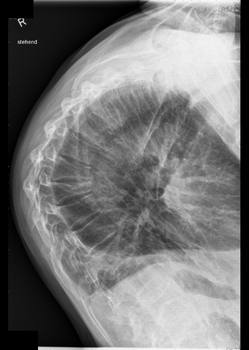The Effect of Posture on the Diaphragm
Top Contributors - Ewa Jaraczewska, Carin Hunter, Jess Bell, Lucinda hampton, Merinda Rodseth and Kim Jackson
Introduction[edit | edit source]
The diaphragm is a fibromuscular sheet that lies between the thorax and abdomen and attaches to the xiphoid process of the sternum, ribs sixth to 12th ribs, and the vertebral bodies of L1 to L3.[1] Its primary function is in respiration. The second important role of the diaphragm is to provide dynamic spinal stabilisation in collaboration with deep stabilisation muscles of the body. This function is possible due to the diaphragm's contribution to increasing intra-abdominal pressure, which plays an important role in spinal stability. [2][3] Disorders of the diaphragm and postural deficiencies can negatively affect respiration, spinal stability, endurance and patient's abilities to complete functional tasks. This article will discuss the relationship between posture and diaphragm function.
The Effect of Posture on the Diaphragm[edit | edit source]
Posture has a significant impact on the function of the diaphragm.[4] To optimise diaphragm function, vertical length is needed - i.e. the thoracic and abdominal cavities need to be long enough for the diaphragm to create negative and positive pressure during inspiration and expiration.[5] A patient must be able to take a deep breath down to the base of the lungs so that the ribs can flare out and the diaphragm can descend.[5] A detailed discussion of breathing is available here and here. However, specific postures such as forward head posture (FHP) and kyphosis have been found to affect breathing mechanics, including diaphragm mobility.[6]
Forward Head Posture[edit | edit source]
FHP is "a poor habitual neck posture that is defined by hyperextension of the upper cervical vertebrae and forward translation of the cervical vertebrae".[7]This postural malalignment can also become a compensatory pain relieving adaptation in chronic neck pain, an adaptation to improve lung capacity in obstructive lung condition or in response to postural changes in the thoracic spine. [8]
FHP affects chest expansion and the activity of the respiratory muscles, which can lead to reduced alveolar ventilation.[6][9] Zafar et al.[6] found that induced FHP in healthy subjects has an immediate impact on respiratory function. They suggested that this could be caused by a temporary entrapment of the phrenic nerve (i.e. the nerve, which supplies the diaphragm). This entrapment decreases neural activity and ultimately weakens the diaphragm.[6]
Patients with forward head posture have reduced diaphragmatic excursion. The abdominal muscle shortening and changes in the shape and expansion of the anteroposterior aspect of the lower thorax can explain this. As a result, diaphragm excursion becomes limited. Hodges et al[10][11] deduced that altered diaphragm function leads to core muscle instability, which can result in other systemic and musculoskeletal disorders, including spinal instability.
A FHP has an impact on respiratory biomechanics.[12] A prolonged forward head posture can lead to kyphotic posture, reduction in the mobility of ribcage, and modification in function of all respiratory muscular attachments such as sternocleidomastoids, intercostals, and the diaphragm. It results in an expansion of the upper thorax and a contraction of the lower thorax. Thoracic elevation observed in forward head posture and decreased mobility of thoracolumbar region is caused by an increased tone in sternocleidomastoid muscle. [13] The biomechanical impacts of forward head posture on respiratory function include development of restrictive lung disorder [12], decreased respiratory function[7], and decreasing the primary respiratory parameters: vital capacity (FVC), forced expiratory volume in the 1st second (FEV1), expiratory reserve volume (ERV), inspiratory reserve volume (iRV), and peak expiratory flow (PEF). [7]Additionally, the forward head posture tends to decrease the SNIP values compared to the normal upright sitting, indicating a reduction in the diaphragm strength.[6]
Interventions[edit | edit source]
For the diaphragm of patients with an FHP to be more effective during breathing, we need to:[14]
- Restore the normal length-tension relationship
- Postural alignment is necessary for effective respiratory muscle training as trunk rotation posture may limit chest wall movement. Diaphragm asymmetry is consistent with trunk rotation which negatively affect an overall lung volume. [15]
- Improve mobility and expansion in the chest wall
- Relieve the load on accessory respiratory muscles in the neck[14]
- Weak, overactive, or tight accessory muscles of respiration (sternocleidomastoid, anterior scalenus) can increase respiratory inefficiency
Watch this 6-minute video on how to measure and correct FHP.
Kyphotic Posture[edit | edit source]
Kyphosis is defined as: "an increase in the forward curvature of the spine that is seen along the sagittal plane".[17]
It can be caused by torticollis (i.e. when the neck twists to one side[6]) and FHP leading to the development of a secondary thoracic curve to compensate for the flattening of the cervical spine curve. Altered cervicothoracic mobility impairs normal breathing mechanics by reducing diaphragm mobility and strength.[6][18]
There is an approximation of the ribs and pelvis in individuals who are slumped in a kyphotic posture. This approximation can increase intra-abdominal pressure, which affects diaphragmatic movement.[6] This can lead to [6]
- Reduced lung capacity
- Reduced inspiratory flow [19]
- Decreased forced vital capacity[20]
Watch this 1-minute video on Kyphosis symptoms.
Respiratory function should, therefore, be assessed in patients presenting with postures such as FHP and torticollis.[6] Zafar et al.[6] recommend that clinicians use the SNIP tool (Sniff Nasal Inspiratory Pressure)[21] to assess respiratory function as it is a simple, easy-to-use method to screen patients with postural dysfunction.[6] It is considered a good measure of global inspiratory muscle strength. The disadvantages of using the test include poor pressure transmission with nasal or airway obstruction, and the test is difficult to perform for patients with bulbar involvement (ALS).
To perform the test, a nasal“Bung” with a pressure catheter is needed. The patient performs a maximum sniff through the unoccluded nostril. Multiple test attempts are completed: ten attempts are usually sufficient to reach a plateau in SNIP values. Greater than ten tests need to be completed if SNIP falls below normal.
Normal values of maximal SNIP can be predicted from age and sex. Sitting or supine during testing does not affect the values, as the maximal SNIP is similar in both positions. The table below shows a normal value and lower limit of normal (LLN) value for SNIP test in men and women of different ages:
| Men | Women | |||
|---|---|---|---|---|
| Age (years) | SNIP (cmH2O) | LLN (cmH2O) | SNIP (cmH2O) | LLN (cmH2O) |
| 20 | 118 | 79 | 91 | 62 |
| 30 | 114 | 75 | 88 | 60 |
| 40 | 110 | 71 | 86 | 58 |
| 50 | 106 | 67 | 84 | 56 |
| 60 | 102 | 62 | 82 | 54 |
| 70 | 97 | 58 | 80 | 51 |
| 80 | 93 | 54 | 77 | 49 |
| 90 | 89 | 50 | 75 | 47 |
Adapted from: Rafferty G. Respiratory Muscle Testing Reference Equations. ARTP 2020
The below 4-minute video shows how to use an SNIP tool.
Posture in an ICU Bed[edit | edit source]
Pillows are often placed under patients' heads and knees in ICU settings to make them comfortable in bed. However, this positioning causes them to lie in a 'hammock' position, which reduces the ability of the diaphragm to function optimally.[5]
Poor ICU positioning results in:[5]
- Increased forward head angle
- Increased apical breathing
- Decreased diaphragmatic breathing
The consequences of this include:[5]
- Anterior neck muscle tightness
- Cervical extensor muscle weakness
- Diaphragmatic weakness
Other Factors to Consider[edit | edit source]
The diaphragm influences:[5]
- Oesophageal function
- Digestive function
- Peristaltic movements, massaging of the abdominal contents
- Vascular function, such as blood pressure
- Immune system
- The diaphragm helps with immunity because it creates "fresh flow"[5] and assists with the absorption of nutrients and vitamins
More information on the roles of the diaphragm is available here.
References[edit | edit source]
- ↑ Xuan D. Functional Anatomy of the Thoracic Spine and Rib Cage. Plus Course 2023
- ↑ Vostatek P, Novák D, Rychnovský T, Rychnovská S. Diaphragm postural function analysis using magnetic resonance imaging. PLoS One. 2013;8(3):e56724.
- ↑ Kolar P, Sulc J, Kyncl M, Sanda J, Neuwirth J, Bokarius AV, Kriz J, Kobesova A. Stabilizing function of the diaphragm: dynamic MRI and synchronized spirometric assessment. J Appl Physiol (1985). 2010 Oct;109(4):1064-71.
- ↑ Safavi S, Arthofer C, Cooper A, Harkin JW, Prayle AP, Sovani MP, Bolton CE, Gowland PA, Hall IP. Assessing the impact of posture on diaphragm morphology and function using an open upright MRI system- A pilot study. Eur J Radiol. 2020 Sep;130:109196.
- ↑ 5.0 5.1 5.2 5.3 5.4 5.5 5.6 Pandya R. The Effect of Posture on the Diaphragm Course. Plus, 2021.
- ↑ 6.00 6.01 6.02 6.03 6.04 6.05 6.06 6.07 6.08 6.09 6.10 6.11 Zafar H, Albarrati A, Alghadir AH, Iqbal ZA. Effect of different head-neck postures on the respiratory function in healthy males. BioMed research international. 2018 Jul 12;2018.
- ↑ 7.0 7.1 7.2 Koseki T, Kakizaki F, Hayashi S, Nishida N, Itoh M. Effect of forward head posture on thoracic shape and respiratory function. Journal of Physical Therapy Science. 2019;31(1):63-8.
- ↑ Ahmad AM, Kamel KM, Mohammed RG. Effect of forward head posture on diaphragmatic excursion in subjects with non-specific chronic neck pain. A case-control study. Physiother Quart. 2020;28(3):9–13
- ↑ Okuro RT, Morcillo AM, Ribeiro MÂ, Sakano E, Conti PB, Ribeiro JD. Mouth breathing and forward head posture: effects on respiratory biomechanics and exercise capacity in children. Jornal Brasileiro de Pneumologia. 2011;37:471-9.
- ↑ Hodges PW, Gurfinkel VS, Brumagne S, Smith TC, Cordo PC. Coexistence of stability and mobility in postural control: evidence from postural compensation for respiration. Experimental brain research. 2002 Jun;144(3):293-302.
- ↑ Hodges PW, Butler JE, McKenzie DK, Gandevia SC. Contraction of the human diaphragm during rapid postural adjustments. J Physiol. 1997;505 ( Pt 2)(Pt 2):539-48.
- ↑ 12.0 12.1 Triangto K, Widjanantie SC, Nusdwinuringtyas N. Biomechanical Impacts of Forward Head Posture on the Respiratory Function. Indonesian Journal of Physical Medicine & Rehabilitation. 2019;8(02):50-64.
- ↑ Huggare JA, Laine-Alava MT. Nasorespiratory function and head posture. Am J Orthod Dentofacial Orthop 1997;112(5):507-11.
- ↑ 14.0 14.1 Haghighat F, Moradi R, Rezaie M, Yarahmadi N, Ghaffarnejad F. Added Value of Diaphragm Myofascial Release on Forward Head Posture and Chest Expansion in Patients With Neck Pain: A Randomized Controlled Trial.
- ↑ 15.0 15.1 Jung JH, Kim NS. Changes in training posture induce changes in the chest wall movement and respiratory muscle activation during respiratory muscle training. J Exerc Rehabil. 2018 Oct 31;14(5):771-777.
- ↑ Cao Y, Li P, Wang Y, Liu X, Wu W. Diaphragm Dysfunction and Rehabilitation Strategy in Patients With Chronic Obstructive Pulmonary Disease. Front Physiol. 2022 May 2;13:872277.
- ↑ Lam JC, Mukhdomi T. Kyphosis. [Updated 2021 Aug 11]. In: StatPearls [Internet]. Treasure Island (FL): StatPearls Publishing; 2021 Jan-. Available from: https://www.ncbi.nlm.nih.gov/books/NBK558945/
- ↑ Chaitow L. Functional movement and breathing dysfunction. Journal of bodywork and movement therapies. 2016 Jul 1;20(3):455-6.
- ↑ Lin F, Parthasarathy S, Taylor SJ, Pucci D, Hendrix RW, Makhsous M. Effect of different sitting postures on lung capacity, expiratory flow, and lumbar lordosis. Archives of physical medicine and rehabilitation. 2006 Apr 1;87(4):504-9.
- ↑ Haque MF, Akhter S, Tasnim N, Haque M, Paul S, Begum M. Effects of different sitting postures on forced vital capacity in healthy school children. Bangladesh Medical Research Council Bulletin. 2019 Aug 7;45(2):117-21.
- ↑ Prigent H, Lejaille M, Falaize L, Louis A, Ruquet M, Fauroux B, Raphael JC, Lofaso F. Assessing inspiratory muscle strength by sniff nasal inspiratory pressure. Neurocritical care. 2004 Dec;1(4):475-8.
- ↑ ALS Centrum Nederland. SNIP (Sniff nasal inspiratory pressure). Available from: https://www.youtube.com/watch?v=9bQgY2ZaiLk [last accessed 3/12/2021]








